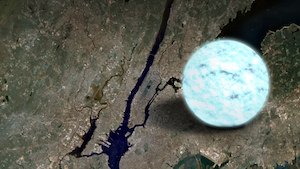Neutron Stars, Pulsars & Magnetars
Neutron stars are formed when a massive star runs out of fuel and collapses. The very central region of the star – the core – collapses, crushing together every proton and electron into a neutron. If the core of the collapsing star is between about 1 and 3 solar masses, these newly-created neutrons can stop the collapse, leaving behind a neutron star. (Stars with higher masses will continue to collapse into stellar-mass black holes.)
A neutron star is the densest object astronomers can observe directly, crushing half a million times Earth's mass into a sphere about 12 miles across, or similar in size to Manhattan Island, as shown in this illustration. (Credit: NASA's Goddard Space Flight Center)
This collapse leaves behind the most dense object known – an object with the mass of a sun squished down to the size of a city. These stellar remnants measure about 20 kilometers (12.5 miles) across. One sugar cube of neutron star material would weigh about 1 trillion kilograms (or 1 billion tons) on Earth – about as much as a mountain.
Since neutron stars began their existence as stars, they are found scattered throughout the galaxy in the same places where we find stars. And like stars, they can be found by themselves or in binary systems with a companion.
Many neutron stars are likely undetectable because they simply do not emit enough radiation. However, under certain conditions, they can be easily observed. A handful of neutron stars have been found sitting at the centers of supernova remnants quietly emitting X-rays. More often, though, neutron stars are found spinning wildly with extreme magnetic fields as pulsars or magnetars. In binary systems, some neutron stars can be found accreting materials from their companions, emitting electromagnetic radiation powered by the gravitational energy of the accreting material. Below we introduce two general classes of non-quiet neutron star – pulsars and magnetars.
Pulsars
Most neutron stars are observed as pulsars. Pulsars are rotating neutron stars observed to have pulses of radiation at very regular intervals that typically range from milliseconds to seconds. Pulsars have very strong magnetic fields which funnel jets of particles out along the two magnetic poles. These accelerated particles produce very powerful beams of light. Often, the magnetic field is not aligned with the spin axis, so those beams of particles and light are swept around as the star rotates. When the beam crosses our line-of-sight, we see a pulse – in other words, we see pulsars turn on and off as the beam sweeps over Earth.
One way to think of a pulsar is like a lighthouse. At night, a lighthouse emits a beam of light that sweeps across the sky. Even though the light is constantly shining, you only see the beam when it is pointing directly in your direction. The video below is an animation of a neutron star showing the magnetic field rotating with the star. Partway through, the point-of-view changes so that we can see the beams of light sweeping across our line of sight – this is how a pulsar pulses.
Magnetars
Another type of neutron star is called a magnetar. In a typical neutron star, the magnetic field is trillions of times that of the Earth's magnetic field; however, in a magnetar, the magnetic field is another 1000 times stronger.
In all neutron stars, the crust of the star is locked together with the magnetic field so that any change in one affects the other. The crust is under an immense amount of strain, and a small movement of the crust can be explosive. But since the crust and magnetic field are tied, that explosion ripples through the magnetic field. In a magnetar, with its huge magnetic field, movements in the crust cause the neutron star to release a vast amount of energy in the form of electromagnetic radiation. A magnetar called SGR 1806-20 had a burst where in one-tenth of a second it released more energy than the sun has emitted in the last 100,000 years!



Comments